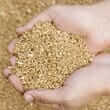Background
- QK-77 is a type of wheat (Triticum turgidum subsp. turanicum) marketed by Kamut International USA and Kamut Enterprises of Europe under the trademark Kamut®. Kamut® is a high-protein grain, similar to durum wheat. The grains are 2-3 times the size of common wheat, contain 20-40% more protein, and are higher in lipids, amino acids, vitamins, and minerals. Kamut® is not to be confused with different varieties of wheat, such as Polish wheat or farro.
- Kamut® is available as whole grain, flour, and bulgur and may also be found in various specialty products, including cereals, breads, cakes, biscuits, pasta, and frozen meals. It is promoted as being suitable for those with wheat intolerance and also as a more nutritious alternative to wheat.
References
- Abdel-Aal el, Young JC, Rabalski I, et al. Identification and quantification of seed carotenoids in selected wheat species. J Agric Food Chem 2007;55(3):787-794. View Abstract
- Rozan P, Kuo YH, Lambein F. Free amino acids present in commercially available seedlings sold for human consumption. A potential hazard for consumers. J Agric Food Chem 2000;48(3):716-723. View Abstract
- Simonato B, Pasini G, Giannattasio M, et al. Allergenic potential of Kamut wheat. Allergy 2002;57(7):653-654. View Abstract







